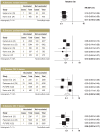The efficacy and duration of vaccine protection against human papillomavirus: a systematic review and meta-analysis
- PMID: 25249360
- PMCID: PMC4174682
- DOI: 10.3238/arztebl.2014.0584
The efficacy and duration of vaccine protection against human papillomavirus: a systematic review and meta-analysis
Abstract
Background: The German Standing Committee on Vaccination (STIKO) recommends vaccination against human papillomaviruses (HPV) of the high-risk types 16 and 18. The duration of protection afforded by HPV vaccines has been reported in multiple studies to date but has not been systematically evaluated.
Method: Systematic literature review and meta-analysis on the efficacy of vaccination, with assessment of evidence by the GRADE criteria (Grading of Recommendations Assessment, Development and Evaluation).
Results: 15 studies were identified: 10 randomized controlled trials (RCTs) and 5 observational studies. The RCTs included a total of 46 436 participants. The duration of follow-up was short (median, 3 years) in 8 RCTs and long (median, 6 years) in 2 RCTs. During the period of short-term follow up, the pooled efficacy of vaccination for the study endpoint of incident HPV infection (percentage of infections prevented) was 83% (95% confidence interval [CI]: 70-90% ), while the pooled efficacy against persistent HPV infection was 90% (95% CI: 79-95% ). In this period, CIN 2+ lesions were prevented with 84% efficacy (95% CI: 50-95% ), and CIN 3+ lesions with 94% efficacy (95% CI: 83-98% ). During the period of long-term follow-up, incident infections were prevented with 94% efficacy (95% CI: 80-98% ) and persistent infections with 95% efficacy (95% CI: 84-99% ). The long-term efficacy against CIN 2+ lesions was 86% (95% CI: -166-99% ). No data are available on the long-term efficacy of vaccination against CIN 3+ lesions.
Conclusion: Long-term observation does not indicate any loss of antiviral protection after vaccination against HPV 16 and 18, although the evidence for long-term protection is of lesser quality than that for short-term protection.
Figures
Comment in
-
Unethical approach.Dtsch Arztebl Int. 2015 Mar 20;112(12):209. doi: 10.3238/arztebl.2015.0209a. Dtsch Arztebl Int. 2015. PMID: 25838023 Free PMC article. No abstract available.
-
Questionable pooling of data.Dtsch Arztebl Int. 2015 Mar 20;112(12):209-10. doi: 10.3238/arztebl.2015.0209b. Dtsch Arztebl Int. 2015. PMID: 25838024 Free PMC article. No abstract available.
-
In reply.Dtsch Arztebl Int. 2015 Mar 20;112(12):210. doi: 10.3238/arztebl.2015.0210. Dtsch Arztebl Int. 2015. PMID: 25838025 Free PMC article. No abstract available.
References
-
- Robert Koch-Institut, Gesellschaft der Epidemiologischen Krebsregister in Deutschland e.V. 2013. Krebs in Deutschland 2009/2010.
-
- Schiffman M, Castle PE, Jeronimo J, Rodriguez AC, Wacholder S. Human papillomavirus and cervical cancer. Lancet. 2007;370:890–907. - PubMed
-
- Delere Y, Remschmidt C, Leuschner J, Schuster M, Fesenfeld M, Schneider A, et al. Human Papillomavirus prevalence and probable first effects of vaccination in 20 to 25 year-old women in Germany: a population-based cross-sectional study via home-based self-sampling. BMC infectious diseases. 2014;14 - PMC - PubMed
-
- McCredie MR, Sharples KJ, Paul C, Baranyai J, Medley G, Jones RW, et al. Natural history of cervical neoplasia and risk of invasive cancer in women with cervical intraepithelial neoplasia 3: a retrospective cohort study. The lancet oncology. 2008;9:425–434. - PubMed
-
- Gerhardus A. Wie wirksam ist die HPV-Impfung? Dtsch Arztebl. 2009;106:A 330–A 334.
Publication types
MeSH terms
Substances
LinkOut - more resources
Full Text Sources
Other Literature Sources
Medical




